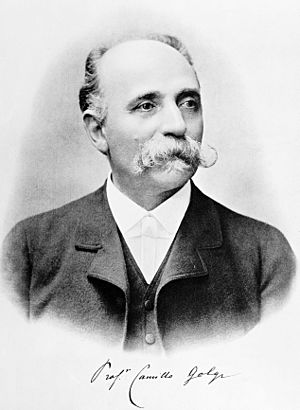Golgi facts for kids
Golgi refers to several things, mostly named after an important Italian scientist named Camillo Golgi. He was a doctor and researcher who studied the human body, especially the brain and nervous system.
One of the most famous things named after him is the Golgi apparatus, which is a tiny part inside almost every living cell. Think of it like a cell's post office or packaging center!
Contents
Camillo Golgi: A Pioneer in Science
Camillo Golgi was born in Italy in 1843. He became a doctor and spent his life studying the human body, especially how our brains and nerves work. Back then, it was very hard to see tiny cells and understand their shapes.
Golgi was very clever and invented a special way to stain cells. This method made it possible to see individual nerve cells clearly for the first time. This discovery was a huge step forward in understanding the brain. Because of his important work, he won the Nobel Prize in 1906.
The Golgi Apparatus: A Cell's Packaging Center
The Golgi apparatus (also known as the Golgi complex) is a small but very important part found inside eukaryotic cells. Eukaryotic cells are the types of cells that make up plants, animals, fungi, and many other living things, including you!
Imagine a factory that makes different products. The Golgi apparatus is like the factory's shipping and receiving department. It takes proteins and fats (called lipids) that the cell has made. Then, it sorts, modifies, and packages them into small sacs called vesicles. These vesicles then carry the packaged materials to different parts of the cell or even outside the cell.
This organelle is super important for many cell jobs. It helps build the cell wall in plants and creates lysosomes, which are like the cell's recycling centers. Without the Golgi apparatus, cells wouldn't be able to send their important products where they need to go!
The Golgi Method: Staining Nerve Cells
The Golgi method (or Golgi stain) is the special staining technique that Camillo Golgi invented. Before this method, scientists found it very hard to see individual nerve cells. They looked like a tangled mess under the microscope.
Golgi's stain used silver salts to color only a few nerve cells completely black. This made them stand out clearly against the unstained background. It was like turning on a spotlight for specific cells! This allowed scientists to see the full shape of nerve cells, including their long branches. This discovery helped other scientists, like Santiago Ramón y Cajal, understand how nerve cells connect and form networks in the brain.
Golgi Crater: A Mark on the Moon
Because of Camillo Golgi's huge contributions to science, a crater on the Moon was named after him. The Golgi (crater) is a small bowl-shaped dip on the Moon's surface. It's a way to remember and honor his lasting impact on our understanding of biology and medicine.
See also
 In Spanish: Golgi para niños
In Spanish: Golgi para niños


